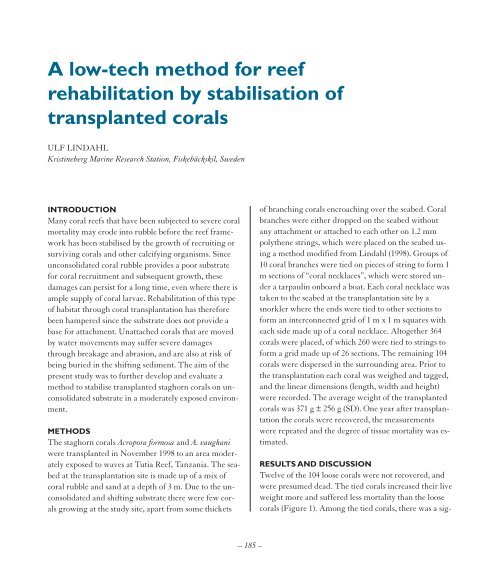You also want an ePaper? Increase the reach of your titles
YUMPU automatically turns print PDFs into web optimized ePapers that Google loves.
A low-tech method for reef<br />
rehabilitation by stabilisation of<br />
transplanted corals<br />
ULF LINDAHL<br />
Kristineberg Marine Research Station, Fiskebäckskil, Sweden<br />
INTRODUCTION<br />
Many coral reefs that have been subjected to severe coral<br />
mortality may erode into rubble before the reef framework<br />
has been stabilised by the growth of recruiting or<br />
surviving corals and other calcifying organisms. Since<br />
unconsolidated coral rubble provides a poor substrate<br />
for coral recruitment and subsequent growth, these<br />
damages can persist for a long time, even where there is<br />
ample supply of coral larvae. Rehabilitation of this type<br />
of habitat through coral transplantation has therefore<br />
been hampered since the substrate does not provide a<br />
base for attachment. Unattached corals that are moved<br />
by water movements may suffer severe damages<br />
through breakage and abrasion, and are also at risk of<br />
being buried in the shifting sediment. The aim of the<br />
present study was to further develop and evaluate a<br />
method to stabilise transplanted staghorn corals on unconsolidated<br />
substrate in a moderately exposed environment.<br />
METHODS<br />
The staghorn corals Acropora formosa and A. vaughani<br />
were transplanted in November 1998 to an area moderately<br />
exposed to waves at Tutia Reef, Tanzania. The seabed<br />
at the transplantation site is made up of a mix of<br />
coral rubble and sand at a depth of 3 m. Due to the unconsolidated<br />
and shifting substrate there were few corals<br />
growing at the study site, apart from some thickets<br />
of branching corals encroaching over the seabed. Coral<br />
branches were either dropped on the seabed without<br />
any attachment or attached to each other on 1.2 mm<br />
polythene strings, which were placed on the seabed using<br />
a method modified from Lindahl (1998). Groups of<br />
10 coral branches were tied on pieces of string to form 1<br />
m sections of “coral necklaces”, which were stored under<br />
a tarpaulin onboard a boat. Each coral necklace was<br />
taken to the seabed at the transplantation site by a<br />
snorkler where the ends were tied to other sections to<br />
form an interconnected grid of 1 m x 1 m squares with<br />
each side made up of a coral necklace. Altogether 364<br />
corals were placed, of which 260 were tied to strings to<br />
form a grid made up of 26 sections. The remaining 104<br />
corals were dispersed in the surrounding area. Prior to<br />
the transplantation each coral was weighed and tagged,<br />
and the linear dimensions (length, width and height)<br />
were recorded. The average weight of the transplanted<br />
corals was 371 g ± 256 g (SD). One year after transplantation<br />
the corals were recovered, the measurements<br />
were repeated and the degree of tissue mortality was estimated.<br />
RESULTS AND DISCUSSION<br />
Twelve of the 104 loose corals were not recovered, and<br />
were presumed dead. The tied corals increased their live<br />
weight more and suffered less mortality than the loose<br />
corals (Figure 1). Among the tied corals, there was a sig-<br />
– 185 –


















